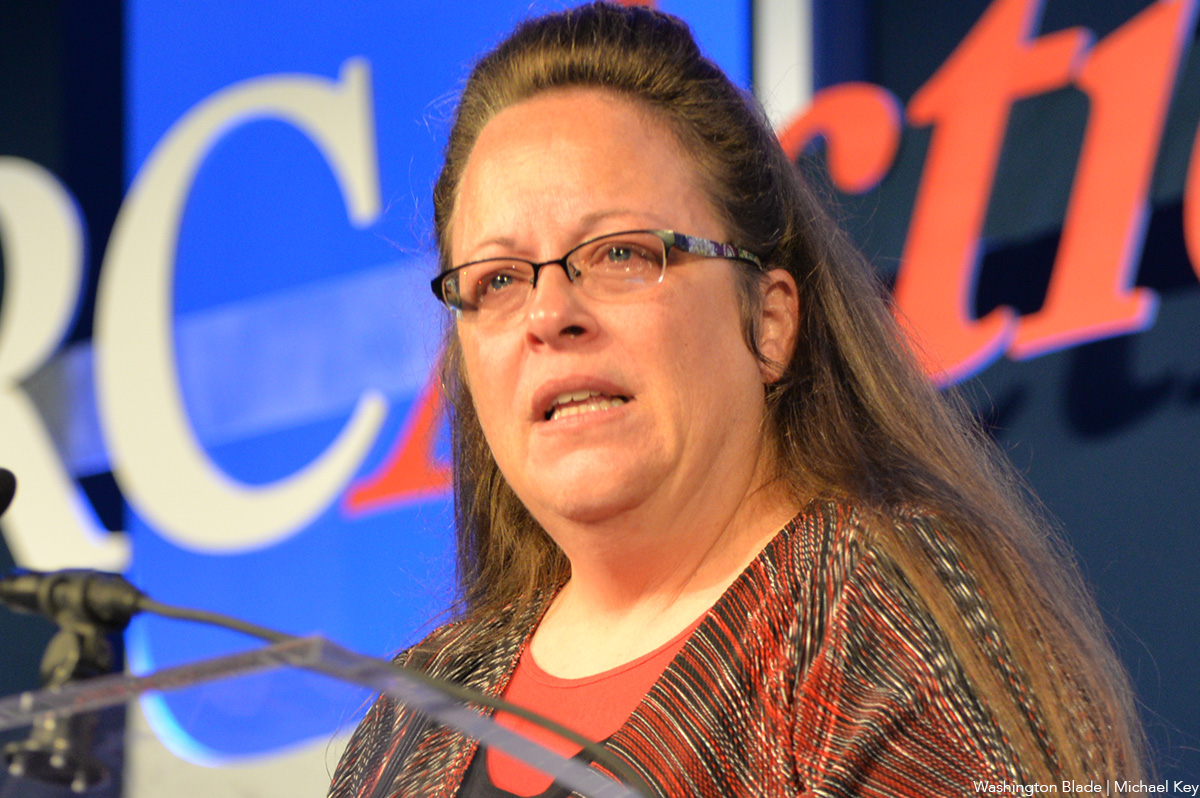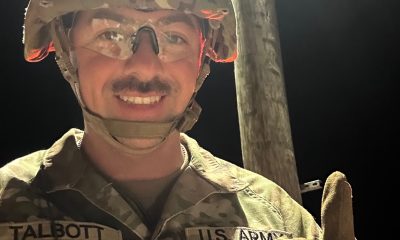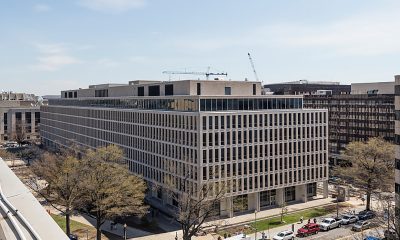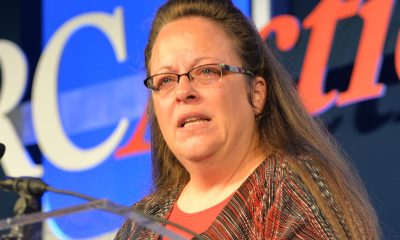National
Gay Sandy victims struggle to recover
Storm surge inundated the New York and New Jersey coastlines.


Superstorm Sandy’s surge destroyed homes along Cedar Grove Avenue in Staten Island, N.Y. (Washington Blade photo by Michael K. Lavers)
STATEN ISLAND, N.Y. –Allison Galdorisi and her wife Claire were inside their home on Hett Avenue in the New Dorp Beach section of Staten Island when Superstorm Sandy’s storm surge began inundating their neighborhood shortly after 7 p.m. on Oct. 29.
The couple opened their front door after they heard a noise and saw two feet of water outside their house. The surge had risen to four feet before Galdorisi and her wife left through a back window — they could not open the front door because of the water. The couple, who clipped their cell phones to their shirt collars and held a flashlight above the floodwaters as they waded through them, climbed over a neighbor’s fence before walking to nearby New Dorp Lane.
Galdorisi and her wife reached dry land at Hylan Boulevard, which runs the length of the South Shore of Staten Island.
“The water was so strong; the current,” Galdorisi told the Washington Blade from Staten Island on Monday afternoon. “There was so much debris.”
Nearly a month after Sandy devastated the New York and New Jersey coastlines, the storm’s aftermath remains clearly visible in the most affected areas.
A pile of debris that had once been a house remains on the corner of Cedar Grove Avenue and Maple Terrace in New Dorp Beach – a few blocks away from Galdorisi’s home and in the same area President Obama toured with New York Gov. Andrew Cuomo, local Congressman Michael Grimm and other officials on Nov. 15. Dozens of cars that had been submerged remain abandoned along the side of streets, while boats that came to rest on beaches and in adjacent marshes are visible from Hylan and Father Capodanno Boulevards.
Wayne Steinman took one final look at the water across the street from his townhouse on Father Capodanno Boulevard in the Midland Beach section of Staten Island before evacuating to his husband Sal Ianullo’s parents’ home in Brooklyn around 2 p.m. on Oct. 29. The tide was already high, but he told the Blade the water was “still contained on the beach where it belonged.”
Up to six feet of water inundated the couple’s home a few hours later — the water shattered three large windows at the front of the house as it flowed through the first floor. The surge also tore the shed and air conditioning unit from the outside wall — the latter has not been found.

Up to six feet of water inundated Wayne Steinman and Sal Ianullo’s Staten Island, N.Y., home during Superstorm Sandy. (Washington Blade photo by Michael K. Lavers)
The couple found some furniture that had been in their living room in their front yard when they returned the next day. Their deck looked like what Steinman described as “toothpicks scattered about.”
“The power of it was intense,” he said. “I do have some neighbors who lived through it and did not evacuate. And the best way to describe it is a tsunami. It wasn’t just water rising and then going away; it was a force of moving water.”
Nine of the more than 40 people who lost their lives during Sandy in New York City were in Midland Beach. This figure includes David Maxwell, a 64-year-old gay man who lived alone in his Mapleton Avenue home after his partner moved into a local nursing home after suffering a stroke.
A man and his 13-year-old daughter drowned when the surge washed away their Yetman Avenue home in the Tottenville section of Staten Island. The New York Daily News reported the family decided not to leave after someone broke into their home after the evacuated during Hurricane Irene that struck New York City in Aug. 2011.
On nearby Manhattan Street, Margie DelGesso and a group of other women were gutting her house that had up to six feet of water in it at the height of the storm. She is currently living with a friend in another part of Staten Island.
“They were talking about how bad it was going to be,” DelGesso told the Blade while talking with this reporter in front of her damaged house. “I would never think I was going to have six feet of water in my house. I didn’t even bring my furniture up, which I did last year. I brought a lot of furniture up for Irene. And this year I was like, ‘nah, I’m all right.’”
“Operation Chocolate Chip Cookie” offers food, coffee to storm victims
A group of women who call themselves “Operation Chocolate Chip Cookie” served pasta and meatballs, homemade turkey soup, potato and egg sandwiches, cookies, cupcakes and hot coffee they were able to brew with a generator the New York Police Department donated from a tent they set up at a nearby intersection as DelGesso and her neighbors gutted and repaired their damaged homes. They have volunteered in other storm-devastated Staten Island neighborhoods.
“We’re just hitting different parts of the island that have been impacted by this tragedy,” South River, N.J., resident Pam McClellan, who grew up on Staten Island, told the Blade before she and other volunteers offered this reporter pasta, bread and three boxes of cookies and cupcakes to bring back to D.C. “We find places to set up shop. We’ll get as many people as we can. We got a good group of girls, a good group of friends who are just willing to help out.”
Volunteers offering clothing, food and other donated items to storm survivors from makeshift distribution centers along the street remain a common sight throughout many Staten Island neighborhoods — several remain along Midland Avenue in Midland Beach. Members of a Brooklyn motorcycle club continue to distribute these items on Cedar Grove Avenue in New Dorp Beach. Galdorisi said they stopped a looter while on patrol a couple of weeks ago.
The Stephen Siller Tunnel to Towers Foundation, which was established in honor of firefighter Stephen Siller who died in the Sept. 11 terrorist attacks after he ran through the Brooklyn Battery Tunnel to join his New York Fire Department colleagues at the World Trade Center, has created a Sandy relief fund. The American Red Cross, which initially faced criticism from Staten Island Borough President James Molinaro in the days immediately after the storm, continues to have a visible presence in Staten Island.
The Federal Emergency Management Agency has six disaster recovery centers in the borough — DelGesso said FEMA deposited two months of rent assistance into her checking account after she applied.

A group of women serve food and coffee in the Tottenville neighborhood of Staten Island, N.Y., on Nov. 25, 2012 (Washington Blade photo by Michael K. Lavers)
Gay Staten Islander coordinates Sandy relief efforts
Michele Karlsberg, who is lesbian comedian Kate Clinton’s publicist, raised $2,500 that she distributed to DelGesso, Galdorisi, Steinman and Iacullo and two other gay Staten Islanders she knew Sandy directly impacted. She directed up to $10,000 she helped raise to the Stephen Siller Tunnel to Towers Foundation.
Karlsberg, whose mother lost everything during the storm and the house in the borough’s Ocean Breeze neighborhood in which she grew up had eight feet of water inside of it after Sandy, continues to post recovery information to her Facebook page. She told the Blade she recently spoke with an NYPD lieutenant who wanted to know where he could send 100 cots and heaters.
Karlsberg directed him to a woman who set up a donation distribution center in New Dorp Beach.
“I sent the guy to her, so that was great,” she said.
As Staten Islanders begin to rebuild, those in other affected areas continue to recover from the storm.
Normal ferry service to Fire Island Pines and Cherry Grove on Fire Island, which saw widespread flooding and severe beach erosion, has resumed. The Long Island Power Authority has also restored electricity to the vast majority of homes in the gay resort communities.
A group of drag queens who perform in Cherry Grove took part in a fundraiser at the Stonewall Inn in Greenwich Village on Sunday night that raised money for the Red Cross and the fund that maintains the dunes to which many local residents point as the reason the hamlet suffered comparatively less damage from Sandy than other areas of Fire Island. Jay Pagano, president of the Fire Island Pines Property Owners Association, is scheduled to meet with local beach erosion control officials to discuss ways to rebuild his community’s dunes.
“Restoration of the dunes is a FIPPOA priority,” he wrote in a Nov. 20 e-mail to Pines residents.
Homeless LGBT youth drop-in center relocates
The Ali Forney Center’s drop-in center for homeless LGBT youth in Manhattan’s West Chelsea neighborhood that flooded during the storm has relocated to the nearby LGBT Community Center.
A fund established to help the organization raise money for a second drop-in center that is scheduled to open in Harlem early next year has thus far raised more than $250,000. Gay MSNBC anchor Thomas Roberts and his husband, Patrick Abner, were among those who attended post-Sandy fundraiser for the Ali Forney Center at a Manhattan bar earlier this month.
Carl Siciliano, the group’s executive director, told the Blade he expects it will cost more than $400,000 to recover what was lost in damaged drop-in center and to move into the new Harlem space.
“To have our drop-in center reduced, to have smaller spaces and all of that is difficult for the kids,” he said. “The basic needs are the same as they were right before the hurricane that they’re not being met. They’re like in a constant state of crisis. By virtue of our space being totally destroyed, in a lot of ways we became the focal point of how LGBT folks were understanding how our community had been hurt by Sandy, although we certainly weren’t the only ones who were badly hurt. Bailey House [an organization that offers housing for people with HIV/AIDS] was badly hurt as well, so in a way it generated a lot more support for us than normal, but the kids are in a constant state of crisis so there’s not nearly enough resources for them. It just escalates it.”
A group of Ali Forney clients and staff recently brought supplies to a group helping Sandy victims in Brooklyn’s hard-hit Red Hook neighborhood. Roberts, who emceed the Ali Forney Center’s annual fall fundraiser four days before Sandy made landfall near Atlantic City, N.J., helped cook Thanksgiving dinner with Abner, actress Ally Sheedy and another couple at a Brooklyn facility that has beds for 20 homeless LGBT youth.
“We live in Hell’s Kitchen and we were not affected at all,” Roberts, who reported from New Orleans after Hurricane Katrina’s storm surge inundated the city in 2005, told the Blade. “I walk to work so I didn’t have to worry about the subway. The lights never went off, so it’s been a real education to hear about and also to cover what everyone has been living through and the pictures really tell the tale of only a small part of it. I know for certain places like Staten Island or Seaside Heights in New Jersey the devastation is as far as the eye can see.”
Lynette Molnar of Provincetown for Women, who produces annual events for lesbian visitors to the resort town on Cape Cod, coordinated the collection of coats, blankets, toiletries, cell phone chargers and other items from local businesses and guesthouses to send to the Stephen Siller Tunnel to Towers Foundation. Her group sent close to 40 large boxes of donations to Staten Island with the Human Rights Campaign paying for the shipping.
“It feels so close to home and there are so many gay people too who live on Staten Island,” Molnar told the Blade. “People just really poured their hearts out. It was so wonderful to be able to see that kind of support.”
Staten Islanders struggle against lack of housing, rumors
Back on Staten Island, gay state Assemblyman Matt Titone said a lack of affordable housing and what he described as the “rumor mill” remain two of the most pressing issues for those recovering from the storm. Shoes, winter clothing and other donated supplies are readily available, but Karlsberg said replacing washing machines and other appliances has proven more of a challenge.
“So much stuff is out there, but people have no place to put it,” she said. “All these things came instantly, but when you get back in your house and you say ‘oh, I don’t have a toaster. You know oh, I don’t have plates.’ But you can’t get any of that stuff now.”
Galdorisi, who grew up in New Dorp Beach, is currently living with family on Staten Island. She hopes she and her wife will return in three months once they rebuild their now gutted house.
“Right now, a lot of people in my neighborhood are actually living in their houses because they are not lucky enough to have family that they can go stay with,” Galdorisi said. “I’m actually one of the lucky ones. Even though I lost my house, I have family that I can stay with. Some of them are still living there. They’re just getting electric back now.”
U.S. Military/Pentagon
Serving America, facing expulsion: Fight for trans inclusion continues on Veterans Day
Advocates sue to reverse Trump ban while service members cope with new struggles

President Trump signed EO 14183, titled “Prioritizing Military Excellence and Readiness,” on Jan. 27, directing the Department of Defense (DoD) to adopt policies that would prohibit transgender, nonbinary, and gender-nonconforming people from serving in the military.
The Trump-Vance administration’s policy shift redefines the qualifications for military service, asserting that transgender people are inherently incapable of meeting the military’s “high standards of readiness, lethality, cohesion, honesty, humility, uniformity, and integrity,” citing a history or signs of gender dysphoria. According to the DoD, this creates “medical, surgical, and mental health constraints on [an] individual.” Regardless of their physical or intellectual capabilities, transgender applicants are now considered less qualified than their cisgender peers.
On Jan. 28, 2025, GLBTQ Legal Advocates and Defenders (GLAD) Law and the National Center for LGBTQ Rights (NCLR) filed Talbott v. Trump, a federal lawsuit in the U.S. District Court for the District of Columbia challenging the executive order. Originally filed on equal protection grounds on behalf of six active service members and two individuals seeking enlistment, the case has since grown to include 12 additional plaintiffs.
The Washington Blade spoke exclusively with Second Lt. Nicolas (Nic) Talbott, U.S. Army, a plaintiff in the case, and with Jennifer Levi, Senior Director of Transgender and Queer Rights at GLAD Law, who is leading the litigation.
For Talbott, serving in the military has been a lifelong aspiration, one he pursued despite the barriers posed by discriminatory policies.
“Being transgender posed quite the obstacle to me achieving that dream,” Talbott told the Blade. “Not because it [being trans] had any bearing on my ability to become a soldier and meet the requirements of a United States soldier, but simply because of the policy changes that we’ve been facing as transgender service members throughout the course of the past decade… My being transgender had nothing to do with anything that I was doing as a soldier.”
This drive was fueled by early life experiences, including the impact of the Sept. 11 terrorist attacks, which shaped his desire to protect his country.
“Even for an eight-year-old kid, [9/11] has a tremendous amount of impact… I remember thinking, you know, this is a terrible thing. Me, and when I grow up, I want to make sure nothing like this ever happens again,” he said. “I’ve still tried to gear my life in a way that I can be preparing myself to eventually help accomplish that mission of keeping America safe from anything like that ever happening again.”
The attacks inspired countless Americans to enlist; according to the New York City government, 181,510 joined active duty and 72,908 enlisted in the reserves in the year following 9/11. Although Talbott was too young to serve at the time, the events deeply influenced his educational and career path.
“For me, [9/11] just kind of helped shape my future and set me on the path that I’m currently on today,” he added. “It ignited my passion for the field, and it’s something that you know, I’ve carried with me into my adult life, into my professional life, and that I hope to have a career in the future.”
Talbott holds a master’s degree in criminology with a focus on counterterrorism and global security, and while completing his degree, he gained practical experience working with the Transportation Security Administration.
Despite the public scrutiny surrounding the lawsuit and the ongoing uncertainty of his military future, Talbott remains grounded in the values that define military service.
“Being so public about my involvement with this lawsuit grants me the very unique opportunity to continue to exemplify those values,” Talbott said. “I’m in a very privileged spot where I can speak relatively openly about this experience and what I’m doing. It’s very empowering to be able to stand up, not only for myself, but for the other transgender service members out there who have done nothing but serve with honor and dignity and bravery.”
The ban has created significant uncertainty for transgender service members, who now face the possibility of separation solely because of their gender identity.
“With this ban… we are all [trans military members] on track to be separated from the military. So it’s such a great deal of uncertainty… I’m stuck waiting, not knowing what tomorrow might bring. I could receive a phone call any day stating that the separation process has been initiated.”
While the Department of Defense specifies that most service members will receive an honorable discharge, the policy allows for a lower characterization if a review deems it warranted. Compensation and benefits differ depending on whether service members opt for voluntary or involuntary separation. Voluntary separation comes with full separation pay and no obligation to repay bonuses, while involuntary separation carries lower pay, potential repayment of bonuses, and uncertain success in discharge review processes.
Healthcare coverage through TRICARE continues for 180 days post-discharge, but reduced benefits, including VA eligibility, remain a concern. Those with 18–20 years of service may qualify for early retirement, though even this is not guaranteed under the policy.
Talbott emphasized the personal and professional toll of the ban, reflecting on the fairness and capability of transgender service members.
“Quite frankly, the evidence that we have at hand points in the complete opposite direction… there are no documented cases that I’m aware of of a transgender person having a negative impact on unit cohesion simply by being transgender… Being transgender is just another one of those walks of life.”
“When we’re losing thousands of those qualified, experienced individuals… those are seats that are not just going to be able to be filled by anybody … military training that’s not going to be able to be replaced for years and years to come.”
Talbott also highlighted the unique discipline, dedication, and value of diversity that transgender service members bring—especially in identifying problems and finding solutions, regardless of what others think or say. That, he explained, was part of his journey of self-discovery and a key reason he wants to continue serving despite harsh words of disapproval from the men leading the executive branch.
“Being transgender is not some sad thing that people go through… This is something that has taken years and years and years of dedication and discipline and research and ups and downs to get to the point where I am today… my ability to transition was essential to getting me to that point where I am today.”
He sees that as an asset rather than a liability. By having a more diverse, well-rounded group of people, the military can view challenges from perspectives that would otherwise be overlooked. That ability to look at things in a fresh way, he explained, can transform a good service member into a great one.
“I think the more diverse our military is, the stronger our military is… We need people from all different experiences and all different perspectives, because somebody is going to see that challenge or that problem in a way that I would never even think of… and that is what we need more of in the U.S. military.”
Beyond operational effectiveness, Talbott emphasized the social impact of visibility and leadership within the ranks. Fellow soldiers often approached him for guidance, seeing him as a trusted resource because of his transgender status.
“I can think of several instances in which I have been approached by fellow soldiers… I feel like you are a person I can come to if I have a problem with X, Y or Z… some people take my transgender status and designate me as a safe person, so to speak.”
With the arrival of Veterans Day, the Blade asked what he wishes the public knew about the sacrifices of transgender service members. His answer was modest.
“Every person who puts on the uniform is expected to make a tremendous amount of sacrifice,” Talbott said. “Who I am under this uniform should have no bearing on that… We shouldn’t be picking and choosing which veterans are worthy of our thanks on that day.”
Jennifer Levi, GLAD Law’s Senior Director of Transgender and Queer Rights, also spoke with the Blade and outlined the legal and human consequences of the ban. This is not Levi’s first time challenging the executive branch on transgender rights; she led the legal fight against the first Trump administration’s military ban in both Doe v. Trump and Stockman v. Trump.
Levi characterized the policy as overtly cruel and legally indefensible.
“This policy and its rollout is even more cruel than the first in a number of ways,” Levi explained. “For one, the policy itself says that transgender people are dishonest, untrustworthy and undisciplined, which is deeply offensive and degrading and demeaning.”
She highlighted procedural abuses and punitive measures embedded in the policy compared to the 2017 ban.
“In the first round the military allowed transgender people to continue to serve… In this round the military policy purge seeks to purge every transgender person from military service, and it also proposes to do it in a very cruel and brutal way, which is to put people through a process… traditionally reserved for kicking people out of the military who engaged in misconduct.”
Levi cited multiple examples of discrimination, including the revocation of authorized retirements and administrative barriers to hearings.
She also explained that the administration’s cost argument is flawed, as removing and replacing transgender service members is more expensive than retaining them.
“There’s no legitimate justification relating to cost… it is far more expensive to both purge the military of people who are serving and also to replace people… than to provide the minuscule amount of costs for medications other service members routinely get.”
On legal grounds, Levi noted the ban violates the Equal Protection Clause.
“The Equal Protection Clause prevents laws that are intended to harm a group of people… The doctrine is rooted in animus, which means a bare desire to harm a group is not even a legitimate governmental justification.”
When asked what she wishes people knew about Talbott and other targeted transgender military members, Levi emphasized their extraordinary service.
“The plaintiffs that I represent are extraordinary… They have 260 years of committed service to this country… I have confidence that ultimately, this baseless ban should not be able to legally survive.”
Other organizations have weighed in on Talbott v. Trump and similar lawsuits targeting transgender service members.
Human Rights Campaign Foundation President Kelley Robinson criticized the ban’s impact on military readiness and highlighted the counterintuitive nature of removing some of the country’s most qualified service members.
“Transgender servicemembers serve their country valiantly, with the same commitment, the same adherence to military standards and the same love of country as any of their counterparts,” Robinson said. “This ban by the Trump administration, which has already stripped transgender servicemembers of their jobs, is cruel, unpatriotic, and compromises the unity and quality of our armed forces.”
Lambda Legal Senior Counsel Sasha Buchert echoed the legal and moral imperative to reverse the policy.
“Every day this discriminatory ban remains in effect, qualified patriots face the threat of being kicked out of the military,” she said. “The evidence is overwhelming that this policy is driven by animus rather than military necessity… We are confident the court will see through this discriminatory ban and restore the injunction that should never have been lifted.”
The White House
Trump targets LGBTQ workers in new loan forgiveness restrictions
A new Trump policy attempts to limit loan forgiveness for federal workers working with LGBTQ issues.

The Trump-Vance administration is moving forward with plans to restrict federal workers from using the Public Service Loan Forgiveness (PSLF) program if their work involves issues related to LGBTQ individuals, immigrants, or transgender children.
Lawsuits were filed last week in more than 20 cities — including Albuquerque, N.M., Boston, Chicago, and San Francisco — challenging the administration’s efforts to withhold loan forgiveness from organizations that oppose the president and his party’s political agenda.
Created by Congress in 2007 and signed into law by then-President George W. Bush, PSLF cancels the federal student loan debts of borrowers who spend a decade or more working in public service. The program covers teachers, nurses, law enforcement officers (including members of the military), and employees of tax-exempt organizations under Section 501(c)(3). Many of those who work to support LGBTQ rights are employed by such organizations — meaning they stand to lose eligibility under the new policy.
As of 2024, more than 1 million Americans have benefited from PSLF, helping erase an estimated $74 billion in student loan debt, according to a Biden-era estimate.
Under the new rule, which takes effect July 1, 2026, the Department of Education will be able to deny loan forgiveness to workers whose government or nonprofit employers engage in activities deemed to have a “substantial illegal purpose.” The power to define that term will rest not with the courts, but with the education secretary.
The rule grants the secretary authority to exclude groups from the program if they participate in activities such as trafficking, illegal immigration, or what it calls the “chemical castration” of children — defined as the use of hormone therapy or puberty-blocking drugs, a form of gender-affirming care sometimes provided to transgender children and teens.
Under Secretary of Education Nicholas Kent defended the change, arguing that the new rule would better serve the American people, despite every major American physician organization research showing gender-affirming care helps more than it harms.
“It is unconscionable that the plaintiffs are standing up for criminal activity,” Kent said in a statement to NPR. “This is a commonsense reform that will stop taxpayer dollars from subsidizing organizations involved in terrorism, child trafficking, and transgender procedures that are doing irreversible harm to children.”
The Williams Institute, a leading research center on sexual orientation and gender identity law and public policy, warned that this — along with other restrictions on federal loan forgiveness — would disproportionately harm LGBTQ Americans. The institute found that more than one-third (35%) of LGBTQ adults aged 18 to 40 — an estimated 2.9 million people — hold over $93.2 billion in federal student loans. About half (51%) of transgender adults, 36% of cisgender LBQ women, and 28% of cisgender GBQ men have federal student loans.
“The proposed restrictions on student loans will particularly affect the nearly one-quarter of LGBTQ adults employed in the public or nonprofit sectors, which qualify for the Public Student Loan Forgiveness program,” said Brad Sears, Distinguished Senior Scholar of Law and Policy at the Williams Institute, who authored a brief on how the proposed changes could impact LGBTQ borrowers. “A recent executive order could potentially disqualify anyone working for an organization involved in gender-affirming care, or possibly those serving transgender individuals more broadly, from the PSLF program.”
U.S. Supreme Court
Supreme Court rejects Kim Davis’s effort to overturn landmark marriage ruling
Justices declined to revisit the Obergefell decision

The U.S. Supreme Court has declined to hear an appeal from Kim Davis, the former Rowan County, Ky., clerk best known for refusing to issue marriage licenses to same-sex couples after the landmark 2015 Obergefell v. Hodges decision legalized same-sex marriage nationwide.
Following the Obergefell ruling, Davis stopped issuing marriage licenses altogether and has since filed multiple appeals seeking to challenge same-sex marriage protections. The court once again rejected her efforts on Monday.
In this latest appeal, Davis sought to overturn a $100,000 monetary award she was ordered to pay to David Moore and David Ermold, a same-sex couple to whom she denied a marriage license. Her petition also urged the court to use the case as a vehicle to revisit the constitutional right to same-sex marriage.
The petition, along with the couple’s brief in opposition, was submitted to the Supreme Court on Oct. 22 and considered during the justices’ private conference on Nov. 7. Davis needed at least four votes for the court to take up her case, but Monday’s order shows she fell short.
Cathy Renna, the director of communications for the National LGBTQ Task Force, a non-profit organization that works towards supporting the LGBQ community through grassroots organizing told the Washington Blade:
“Today’s decision is not surprising given the longshot status of Davis’s claim, but it’s a relief that the Supreme Court will not hear it, given the current make up of the court itself. We hope that this settles the matter and marriage equality remains the law of the land for same-sex couples.”
Human Rights Campaign President Kelley Robinson released the following statement:
“Today, love won again. When public officials take an oath to serve their communities, that promise extends to everyone — including LGBTQ+ people. The Supreme Court made clear today that refusing to respect the constitutional rights of others does not come without consequences.
Thanks to the hard work of HRC and so many, marriage equality remains the law of the land through Obergefell v. Hodges and the Respect for Marriage Act. Even so, we must remain vigilant.
It’s no secret that there are many in power right now working to undermine our freedoms — including marriage equality — and attack the dignity of our community any chance they get. Last week, voters rejected the politics of fear, division, and hate, and chose leaders who believe in fairness, freedom, and the future. In race after race, the American people rejected anti-transgender attacks and made history electing pro-equality candidates up and down the ballot.
And from California to Virginia to New Jersey to New York City, LGBTQ+ voters and Equality Voters made the winning difference. We will never relent and will not stop fighting until all of us are free.”
The Log Cabin Republicans, a organization dedicated to conservative LGBTQ people, praising the Court’s decision.
“After months of hand-wringing and fear-mongering by Gay Inc., Democrats, and the media, the conservative majority on the Supreme Court sided with the American people and common sense and declined to revisit marriage equality,” Interim Executive Director Ed Williams said in a statement. “Just like Justice Amy Coney Barrett hinted at earlier this year, Obergefell is settled. Marriage equality has been, and will continue to be, the law of the land.”
This story is developing and will be updated as more information becomes available.
-

 U.S. Supreme Court3 days ago
U.S. Supreme Court3 days agoSupreme Court rejects Kim Davis’s effort to overturn landmark marriage ruling
-

 District of Columbia3 days ago
District of Columbia3 days agoCapital Pride files anti-stalking complaint against local LGBTQ activist
-

 Movies4 days ago
Movies4 days agoSuperb direction, performances create a ‘Day’ to remember
-

 Theater3 days ago
Theater3 days agoAstounding ‘LIZZIE’ builds on legendary axe murder tale



















